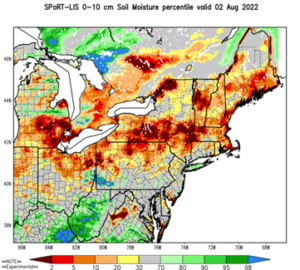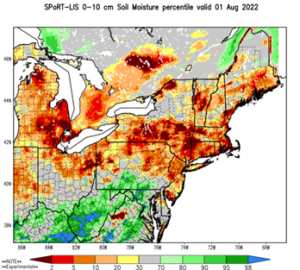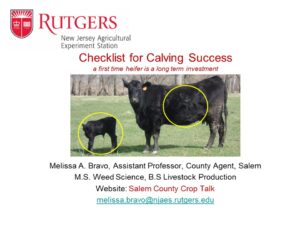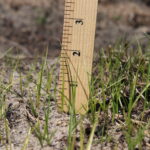Learn more about the weed nutsedge and appropriate management strategies based on the plants growth preferences and dislikes. These resources can be used to develop a short and long term management plan for nutsedge control. Visit the NJAES Weed Management YouTube playlist for a video presentation or download our nutsedge decision tool fact sheet. These resources are one of a five-part weed management series funded by USDA Specialty Crop Block Grant AM190100.
Non-Herbicide Nutsedge Management Resources for Specialty Crop Growers
Much Needed 72 Hour Precipitation Accumulations
Doppler radar polarimetric technology from iWeatherNet.com: Rainfall totals for the last 24 hours to 3 days – high resolution map shows a widespread system brought much needed precipitation to South-Central NJ Sunday, July 31st though the 72-hour period ending August 2, 2022. In Salem County, areas along the Delaware River to west of Woodstown received 5/10ths to 9/10ths in parts of Mullica Hill. A wider swath through Woodstown and Glassboro provided 3/10ths to less than an inch. A narrower swath of 7/10ths to one inch fell from Elmer to Williamstown. Localized areas west of Salem City and South of Abbottstown Meadow received an inch of accumulation. Less than 3.0 inches of rain have been recorded below Memorial Lake at the USGS 393838075194901 Woodstown USGS Gauge for the month of July.
Looking at the Short-term Prediction Research and Transition Center map , soil moisture for surface to ten cm depth readings shifted from below the 3-percentile category for much of the county on August 1st to the 30th percentile as of August 2, but a large area of production remains in the five to ten percentile.
, soil moisture for surface to ten cm depth readings shifted from below the 3-percentile category for much of the county on August 1st to the 30th percentile as of August 2, but a large area of production remains in the five to ten percentile.

Drought driven cow culling. Opportunity for replacement heifers in 2023?
 The July 1, 2022, beef cow inventory compiled by USDA NASS indicates the national beef replacement heifer inventory is below 5 million head. Unprecedented cow culling is occurring in the southwest due to the ongoing drought conditions. To put that in perspective, the United States has not seen numbers this low since 1972 and 1973 when the national beef replacement heifer inventory hovered around 7 million head. Even in 1965, beef cattle replacement heifer inventories were above 5 million head nationally.
The July 1, 2022, beef cow inventory compiled by USDA NASS indicates the national beef replacement heifer inventory is below 5 million head. Unprecedented cow culling is occurring in the southwest due to the ongoing drought conditions. To put that in perspective, the United States has not seen numbers this low since 1972 and 1973 when the national beef replacement heifer inventory hovered around 7 million head. Even in 1965, beef cattle replacement heifer inventories were above 5 million head nationally.
New Jersey reported 5,000 head of beef cattle replacements in 1973 and only 2,500 head in 2019. With all cattle and calve numbers in 2020 reported at 28,000 head down 2,000 head from 2019, it is probable that state raised beef heifer replacement numbers are below 5,000 head going into the fall of 2022.
What is more contrasting compared to 1973 is the difference in calf crops. In 1973, the national calf crop was estimated at 50 million head. Going into summer of 2022 the calf crop is estimated at 25 million head. With an estimated 5,000 of these 500 lb calves or less in weight coming from New Jersey and only half assumed to be heifers, these heifers have considerable value beyond the feedlot, if they have brood cow qualities. Maintaining those selected for replacement herd purposes requires considerable attention to body conditioning to grow a weaned heifer to be bred at 15 months to meet industry replacement standards.
To learn more about raising replacement heifers contact Melissa Bravo for a copy of ‘A Checklist For Calving Success. A first-time heifer is a long-term investment.’
What are replacement heifers worth? The USDA AMS Show-Me-Select Special – Carthage, MO Livestock, Poultry, & Grain May 2022 report is a good example of the criteria that brings $1450.00 to $3,100 bred replacement heifer sale prices. Remember, these heifers were born, weaned, and fed through 15 months of age on 2019 (conception), 2020 (birth year), 2021 (breeding year) feed prices.
- All met minimum standards for reproductive soundness, pelvic size, body condition and weight.
- All immunized including Brucellosis calf-hood vaccination and tested negative for PI BVD.
- Heifers bred to bulls meeting strict calving ease or birth weight EPD’s.
- Many were synchronized and artificially bred.
- Projected calving dates were given.
- All heifers pregnancy checked within 30 days of sale.
- Sale animals screened for blemishes, muscle, frame and body condition score, and disposition.
- Heifers sorted and sold according to calving dates and similar body types.
- The average price per head was $1913.00. The highest selling lot brought $3100.00 per head.
- The A.I. bred heifers brought $141.00 more than natural bred heifers.
- About 40% of the heifers were black, 30% black, white-face, and 30% red.
Salem County Producers: If you would like to host a calf crop evaluation pasture walk for replacement heifer qualities, contact Melissa Bravo at the Salem County Extension Office.
Can we implement a quick fix for heat stress?
Heat Stress Management in the Dairy Herd
to see the article.
“The best time to strategize about heat stress mitigation is early spring when there is still some frost on the ground in the mornings. Or better yet . . . planning for next summer’s heat abatement plan could be done in the previous fall when the shortcomings of the current cooling strategies are fresh on everyone’s mind. However, that doesn’t mean that when we are in the thick of the summer stress we can’t implement new ideas. The goal during these times may be attempting to maintain feed intake during heat stress.”
Veterinary livestock case studies and pinkeye alert
Livestock producers will benefit from a blog on the South Dakota University website for the Department of Veterinary & Biomedical Sciences documenting interesting case diagnostics. The site can be found at https://www.sdstate.edu/veterinary-biomedical-sciences/whats-doc-case-reports.
Additional veterinary livestock case study sites:
https://tvmdl.tamu.edu/case-study-library/case-study-library-bovine/
If you don’t already have this book in your library, consider getting a copy of the https://www.merckvetmanual.com/.
Pinkeye reports are coming in more frequently in drought stricken areas of the western Unite States. With show season underway and cattle moving across states, be on the alert for pinkeye cases cropping up as dry and hot weather conditions continue.
University of Kentucky resource: https://ruminant.ca.uky.edu/files/factsheet_on_pinkeye_final.pdf
July Pest Scouting Nursery, Landscape, and Christmas Trees – Key borer and scale insect control timings
Pest Scouting – Please refer to these documents for a full listing of insects pests for your area corresponding to growing degree-days (GDDs).
- Nursery and Landscape Pest Scouting Guide 2022 PDF (note this contains conifer pests as well)
- Conifer Pest Scouting Guide 2022 PDF
Quick look guides for July (Borers and Scales) and (All other)
Contact if seeing insects at different times: twaller@njaes.rutgers.edu (or call the Cumberland County Extension Office – 856-451-2800)
The following key groups of pests will be active, vulnerable, or otherwise treatable during the next month throughout most of NJ. Here, scale insects and borers with key life stage events during the 1000-2500 GDD timeframe are discussed. Note there are many other insect pests present this time of year so please view the pest scouting guides above for your particular needs.
| Projected GDD50 Accumulation as of July 13 2022 | Note: Growing degree-day values utilize daily average air temperatures with a minimum temperature threshold (a.k.a. ‘base’) of 50F = GDD50 (max. temp. threshold set at 95F). These values are accumulated from a biofix date, such as January or March 1st in the NE USA. Provided GDD50 are scouting ranges and should be truthed. | |||||
| Region | Location | Station | 13-Jul | 1-Aug | 1-Sep | |
| South | Upper Deerfield | NJ50 | 1598 | 2115 | 2905 | |
| Central | Howell / Freehold | NJ10 | 1383 | 1871 | 2594 | |
| North | High Point | NJ59 | 1132 | 1541 | 2138 | |
| Forecast: NOAA NCEP Coupled Forecast System model version 2 (CFSv2) forecast system (3.5 months) (USPEST.ORG) | ||||||
Refer to this post “Obtaining your local growing degree-days” for additional information
| BORER Insect Activity for 1000-2500 GDD (~ July) | ||||||
| Crop type | Common Name | Scientific Name | GDD Min (50F) | GDD Max (95F) | Reference | Developmental / Target Stage |
| Many | Roundheaded appletree borer | Saperda candida | 802 | 1129 | RU | Adults |
| Ash | Emerald ash borer | Agrilus planipennis | 1000 | 1200 | 4 | Peak adult activity |
| Many | Roundheaded apple tree borer | Saperda candida | 1514 | 1798 | 5 | Typical treatment window |
| Conifer | Nantucket tip moth | Rhyacionia frustrana | 1514 | 1917 | RU | Adults 2nd generation |
| Maple | Sugar maple borer | Glycobius speciosus | 2032 | 2375 | 5 | Typical treatment window |
| Locust | Locust borer | Magacyllene robiniae | 2271 | 2805 | 5 | Typical treatment window |
| Poplar and Willow | Poplar and willow borer | Crytorhynchus lapathi | 2271 | 2806 | 5 | Typical treatment window |
Click here – “Identifying Clearwing Moth Borers in Pheromone Traps” or “Differentiating the Common Wood Borers of Ash Trees”
| SCALE Insect Activity for 1000 – 2500 GDD (~ July) | ||||||
| Crop type | Common Name | Scientific Name | GDD Min (50F) | GDD Max (95F) | Reference | Developmental / Target Stage |
| Conifer | Cryptomeria scale | Aspidiotus cryptomeriae | 600 | 800 | 3 | First crawler emergence |
| Many | White prunicola scale | Psedaulacaspis prunicola | 707 | 1151 | RU | Crawlers (1st generation) |
| Conifer | Juniper scale | Carulaspis juniperi | 707 | 1260 | RU | Crawlers (1st generation) |
| Many | Calico scale | Eulecanium cerasorum | 714 | – | 6 | Crawlers (1st generation) |
| Conifer | Striped pine scale | Toumeyella pini | 750 | 800 | 4 | Egg hatch |
| Oak, hickory, birch, many | Oak leacanium scale | Parthenolecanium quercifex | 789 | – | 6 | Crawlers (1st generation) |
| Acer | Cottony maple leaf scale | Pulvinaria acericola | 802 | 1265 | 5 | Crawlers (1st generation) |
| Many, shadetrees | Cottony maple scale | Pulvinaria innumerabilis | 802 | 1265 | RU | Crawlers (1st generation) – control target |
| Oaks | Golden oak scale | Asterolecanium variolosum | 802 | 1266 | 5 | Egg hatch |
| Maples | Japanese maple scale | Lopholeucaspis japonica | 829 | – | 6 | Crawlers (1st generation) |
| Elm | European elm scale | Gossyparia spuria | 831 | 1388 | 6,2 | Crawlers (1st generation) |
| Shade trees | European fruit lecanium scale | Parthenolecanium corni | 932 | 1645 | 6,RU | Crawlers – control target |
| Conifer | Pine tortoise scale | Toumeyella parvicornis | 1000 | 1200 | 4 | Egg hatch ends, last of crawlers |
| Yew, many conifers | Fletcher Scale (Yew) | Parthenolecanium fletcheri | 1029 | 1388 | RU | Crawlers (1st generation) – control target |
| Many | Indian wax scale | Ceroplastes ceriferus | 1145 | – | 6 | Crawlers (1st generation) |
| Euonymus | Euonymus Scale | Unaspis euonymil | 1150 | 1388 | 5 | 2nd generation targeted treatments |
| Shade trees | European fruit lecanium scale | Parthenolecanium corni | 1266 | 1645 | 5 | Crawlers |
| Conifer | Pine Needle Scale | Chionaspis pinifoliae | 1290 | 1917 | 3 | Crawlers emerge (2nd generation) – control target |
| Conifer | Hemlock scale | Abgrallaspis ithacae | 1388 | 2154 | 5 | Typical treatment window |
| Malus, Prunus, many | Peachtree borer | Synanthedon sp. | 1500 | 1800 | RU | Larvae Treatment |
| Many | White prunicola scale | Pseudaulacaspis prunicola | 1637 | – | 6 | Egg hatch / crawler (2nd generation) |
| Euonymus | Euonymus Scale | Unaspis euonymil | 1700 | – | RU | Continued 2nd generation treatments |
| Conifer | Cryptomeria scale | Aspidiotus cryptomeriae | 1750 | 2130 | RU, 4 | Crawlers emerge (2nd generation) |
| Many | Obscure scale | Melanaspis obscura | 1774 | – | 6 | Egg hatch / crawler |
| Conifer | Maskell scale | lepidosaphes pallia | 2035 | – | 6 | Egg hatch / crawler (2nd generation) |
| Mainly Tulip | Tulip tree scale | Toumeyella liriodendri | 2037 | 2629 | RU | Crawlers (1st generation) |
| Mainly Magnolia | Magnolia scale | Neolecanium cornuparvum | 2155 | 2800 | RU | Crawlers (1st generation) |
| Maple | Japanese maple scale | Lopholeucaspis japonica | 2508 | – | 6 | Egg hatch / crawler (2nd generation) |
| Conifer | Elongate hemlock scale | Fiorinia externa | 2515 | 2625 | RU | Typical treatment window – fall activity |
| Yew, many conifers | Fletcher Scale (Yew) | Parthenolecanium fletcheri | 2515 | 2800 | RU | Fall control of overwintering stage |

